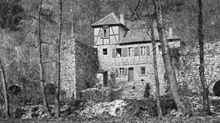Igeler Mill
The Igeler Mühle is a district in the Herrenstrunden district of Bergisch Gladbach . It is the youngest water mill among the mills on the Strunde .
History of the mill
Since 1854 the Brussels lawyer Philipp August Neissen was the sole owner of the Igeler Hof. He wanted to build a stone cutting mill in the vicinity of the lime kilns built in 1860 on the Strunde and supply his homeland Belgium , Holland and Prussia with the prefabricated limestone , which were very interested in this material. On March 7, 1854, the announcement by the Mayor of Gladbach, Herweg, about the Neissen project appeared in the “Public Gazette”. Protests from the neighboring mill owners immediately raged, who feared that the strunde would be polluted and have a negative impact on paper production. Due to the protests presented, Neissen changed his request to the effect that he now applied for the construction of a flour mill. 1856-1858 he had the mill building that still exists today built by Belgian builders. He named the mill after his estate Igeler Mühle. On January 4, 1859, he received a preliminary operating permit with the condition that the timber tree , which was used to regulate the water level and thus the force acting on the mill wheel , could be lowered.
Around this time Theodor Eyberg intended to have a new waterwheel installed in the ship's mill, enlarged to ten feet in diameter, for which the tree had to be raised six inches and the underground by 1¼ feet lower. Neissen appealed against it, but was unsuccessful. As an alternative, on August 24, 1859, he received the final permit to build a waterworks on the Strunderbach, which means that he was allowed to expand the feeder ditches to the Igeler mill.
After Neissen's death around 1880, according to the 1891 address book, Johann Mettmann was the tenant of the mill. There is little evidence for the following years. An invoice received by chance from Theodor Mettmann, Bergisch Gladbach, Grain Milling. Approved for trading in mill products of all kinds and animal feed by the trade license office of the district of Mülheim am Rhein on July 26, 1923. L. No. 142. is for October 21, 1936. In it, Mettmann calculated Franz Eyberg 600 pounds of soy meal and 400 pounds of another Would.
Todays use
Today the old lime kilns have disappeared. The house is used as a residential building and is the seat of the Korean Won Buddhist Meditation Center.
literature
- Determination and order for the Strunderbach, printed by Chr.Illinger, Bergisch Gladbach o. J., (it concerns the Bach order and the Bach protocol from 1823 after a copy from 1854)
- Frank Schulte: The mills on the Strunde , Bergisch Gladbach, 1979, ISBN 3-932326-02-4 .
- Herbert Nicke : Bergische Mühlen, On the traces of the use of water power in the land of a thousand mills between Wupper and Sieg , Wiehl 1998, ISBN 3-931251-36-5 , p. 246.
- Kölner Stadt-Anzeiger: The Igeler mill is the youngest mill in Bergisch Gladbach
Individual evidence
- ^ Andree Schulte, Bergisch Gladbach, city history in street names , published by the Bergisch Gladbach city archive, volume 3, and by the Bergisches Geschichtsverein department Rhein-Berg e. V., Volume 11, Bergisch Gladbach 1995, ISBN 3-9804448-0-5 , p. 187
- ↑ a b c d Hans Leonhard Brenner : The Strunde and their Bergisch Gladbacher Mühlen , Bergisch Gladbach 2012, ISBN 3-932326-67-9 , p. 60ff.
Web links
- The Kölner Stadt-Anzeiger about the Igeler Mühle , accessed on October 15, 2012.
- Website of the Foundation IL - WON Meditation Center in the Igeler Mühle , accessed on January 31, 2013.
Coordinates: 50 ° 59 ′ 54 ″ N , 7 ° 9 ′ 59.3 ″ E


